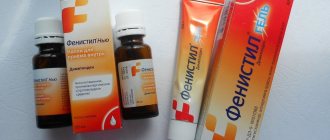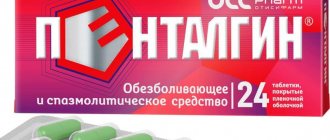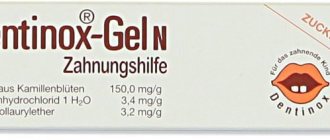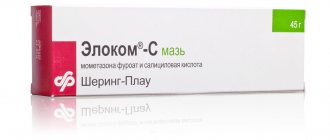The medicine belongs to the subgroup of H1-histamine receptor blockers. Diphenhydramine has a sedative and hypnotic spectrum of action and is not a narcotic. Taking the medication in large dosages or together with alcoholic beverages can cause hallucinations. Diphenhydramine is addictive.
Pharmacodynamics and pharmacokinetics
The main active ingredient is Diphenhydramine . The mechanism of action is based on the inhibitory effect of the drug on central, cholinergic structures, blocking H3-histamine receptors in the brain. Diphenhydramine relieves attacks of itching, tissue edema, hyperemia, prevents spasms of smooth muscle tissue, and has a positive effect on capillary permeability . Taking oral forms causes a short-term feeling of numbness in the mouth. The drug has antiparkinsonian, hypnotic, sedative, and antiemetic effects. By blocking the cholinergic receptors of the ganglia, it reduces blood pressure and can increase existing hypotension . In persons with epilepsy and local brain damage, even low doses of the drug Diphenhydramine can provoke an epileptic attack , and the EEG shows activation of epileptic discharges. The drug is most effective for bronchospasm provoked by taking histamine liberators (morphine, tubocurarine). The drug is least effective for bronchospasm of allergic origin. With repeated doses, the hypnotic and sedative effects are more pronounced. The drug begins to act an hour after entering the body, the effective effect lasts up to 12 hours.
Benefits and harms of use
Reviews from patients who suffer from insomnia indicate that the product helps with the problem. It guarantees a quick fall asleep and sound sleep until the morning. The drug is also effective against infectious diseases.
Despite the large number of advantages, there are also disadvantages. The disadvantages include:
- addictive;
- toxic, so it can provoke hallucinations;
- provokes headaches and poor health in the morning;
- inability to control emotions, inhibition.
A doctor's consultation is required.
Indications for use of Diphenhydramine
Why and for what purpose are tablets and solution prescribed?
The drug is used to relieve allergic reactions, with itchy dermatosis , allergic dermatitis, rhinosinusitis , vasomotor rhinitis, acute iridocyclitis , allergic conjunctivitis. The drug is used for insomnia, chorea, Parkinson's disease, radiation sickness, air sickness, sea sickness, Meniere's syndrome , vomiting in pregnant women. The drug is prescribed as a premedication for extensive traumatic injuries to soft tissues and skin, serum sickness, and hemorrhagic vasculitis .
Features of the composition and pharmacological action of Diphenhydramine
The drug is prepared in tablets and solution for intramuscular or intravenous injection. The main active ingredient of Diphenhydramine is diphenhydramine hydrochloride. Each tablet contains 50 mg of the active ingredient, an additional substance in the solution is purified water.
The medication causes local anesthesia; when consuming the pills, a temporary sensation of loss of sensitivity of the oral mucosa appears. Diphenhydramine has antispasmodic, antiemetic and hypnotic effects. The drug is ineffective in the allergic form of bronchospasm and bronchial asthma.
Contraindications
Diphenhydramine is not prescribed for prostatic hyperplasia, angle-closure glaucoma, epilepsy, bladder stenosis, or stenosing peptic ulcer of the digestive system. For bronchial asthma, breastfeeding, pregnancy, prescribe with caution.
Indications for Diphenhydramine therapy and contraindications
The instructions recommend the use of the medicine for patients:
- with nettle fever, hay fever, vasomotor rhinitis;
- itchy dermatoses, acute iridocyclitis, conjunctivitis of allergic etiology;
- Quincke's edema, capillary toxicosis, reaction to vaccination;
- allergies caused by taking medications or blood transfusions;
- problems with sleep, colds;
- burns, violations of the integrity of the dermis or soft tissues;
- parkinsonism, chorea, Meniere's syndrome;
- air or sea sickness.
Diphenhydramine is prescribed for local anesthesia - in case of intolerance to other painkillers. The medication is included in the complex treatment of anaphylaxis, radiation sickness, and gastrointestinal ulcers.
The drug is contraindicated:
- in case of individual intolerance to the component composition;
- angle-closure glaucoma, enlargement (by weight and volume) of the prostate;
- stenosing gastrointestinal ulcer;
- Marion's disease;
- chronic inflammation of the respiratory tract;
- pyloroduodenal obstruction.
The medicine is not used for pregnant and lactating women, newborns and premature infants.
Side effects
Taking the drug can cause tremor, dizziness, numbness in the oral cavity, dry mouth, increased drowsiness, photosensitivity , asthenia, headaches, nausea, accommodation paresis , decreased speed of psychomotor reaction, and impaired coordination of movements. The use of the drug Diphenhydramine in children may be accompanied by a feeling of euphoria , irritability, and paradoxical insomnia.
Adverse reactions
The abstract indicates the development of non-standard effects during Diphenhydramine therapy:
- a state of general weakness and fatigue, drowsiness;
- decreased concentration, cephalgia with dizziness;
- problems with coordination of movements, unreasonable anxiety;
- increased irritability, nervousness, euphoria;
- insomnia, involuntary muscle tremors;
- neuritis, convulsive syndrome with partial loss of sensitivity;
- decreased visual acuity, diplopia, extraneous noise in the ears.
With local damage to the brain, the drug in any dosage can cause an attack of epilepsy. The medication provokes the appearance of:
- decreased blood pressure, tachycardia, hemolytic anemia;
- dryness of the mucous membranes of the mouth, anorexia, dyspeptic disorders;
- frequent or difficult urination, delayed urine output, early menstruation;
- nasal congestion, breathing problems;
- increased thickness of secretions in the bronchi, a feeling of tightness in the chest;
- nettle fever, anaphylaxis, skin rashes.
Diphenhydramine increases the activity of the sweat glands, causing fever with chills and photosensitivity.
Instructions for use of Diphenhydramine (Method and dosage)
Diphenhydramine tablets, instructions for use
30-50 mg one to three times a day, duration of therapy 10-15 days.
For insomnia, 50 mg is prescribed half an hour before bedtime.
For postencephalic, idiopathic parkinsonism, 25 mg three times a day is initially prescribed, subsequently the dosage is gradually increased to 50 mg 4 times a day.
For motion sickness, you need to take 25-50 mg tablets every 6 hours.
Instructions for use of Diphenhydramine in ampoules
A solution of Diphenhydramine is administered intravenously 20-50 mg of the drug, having previously dissolved in 100 ml of 0.9 sodium chloride, intramuscular injections of 10-50 mg are administered once.
Instructions for the use of rectal suppositories with Diphenhydramine
Rectal suppositories after a cleansing enema are administered twice a day.
Using drops with Diphenhydramine
In ophthalmology, 2 drops of solution (0.2-0.5%) are instilled into each conjunctival sac 3 times a day.
In allergology, 0.05 g of the drug is administered intranasally.
DIMEDROL. Dimedrolum.Properties. White fine-crystalline powder with a bitter taste. Hygroscopic, easily soluble in water. Aqueous solutions are sterilized at 100°C for 30 minutes.
Release form. Available in powder, tablets of 0.025 and 0.05 g and in ampoules of 1 ml of 1% solution.
Store according to list B, in standard packaging, in a place protected from light.
Action and application.
Diphenhydramine reduces the body's response to histamine, relieves the spasm of smooth muscles caused by the latter, reduces capillary permeability, prevents the development of tissue edema caused by histamine, weakens the hypotensive effect of histamine, prevents and weakens the course of allergic reactions. Diphenhydramine, like other antihistamines, blocks the biochemical systems in the tissues affected by histamine and modifies its effect. When administered for prophylactic purposes, diphenhydramine attaches to cell receptors before histamine, and when used for therapeutic purposes, it replaces histamine on cell receptors - it exhibits a competitive effect.
Diphenhydramine has a local anesthetic effect, relaxes smooth muscles, blocks H-cholinergic receptors of the autonomic nodes, increases the excitability of the peripheral cholinergic and adrenoreactive systems of the body, exhibits sedative, moderate hypnotic and antiemetic effects. Its effect begins in 15-30 minutes and lasts 4-6 hours.
Used to relieve allergic reactions, treat urticaria, serum sickness, drug anaphylaxis, pruritic dermatitis, prevent and treat motion sickness in animals, allergic conjunctivitis and rhinitis. Prescribed for asthma in cows, anaphylactic shock, atony and tympanic rumen, retained placenta, metritis, postpartum paresis of cows. For atony and tympany of the rumen, this therapy is useful at the onset of the disease in animals receiving protein-rich food.
Diphenhydramine is sometimes used for polyarthritis, articular and muscular rheumatism (the ointment is rubbed in or injected intradermally). Used to treat anaphylactic shock in cattle caused by sensitization during the administration of biological products, to reduce reactions during blood transfusions and blood-substituting fluids, during radiation sickness, as a sedative in combination with sleeping pills. It is often used in dogs for dermatitis (itching, erythema, eczema, etc.), gastric dilatation, and drug-induced anaphylaxis.
Prescribed orally, intramuscularly, intravenously and locally 1-2 times a day for several (7-12) days. For instillation into the eye, use a 0.5% solution (preferably a 2% solution of boric acid) 1-3 drops 2-3 times a day.
doses :
horses 0.1-0.5 g, cattle 0.3-0.6 g, dogs 0.02-0.04 g;
orally
1.5-2 times more than subcutaneously.
Diphenhydramine overdose
Taking high doses causes depression of the nervous system, paresis of the digestive organs, dry mouth, dilated pupils, and depression. A specific antidote has not been developed; intravenous administration of plasma-substituting fluids and the use of drugs that increase blood pressure are required. It is unacceptable to use analeptics, epinephrine .
In case of severe overdose, death, injury, heart attack, and paralysis are possible.
Customer Reviews
Customer reviews indicate a high effect from taking it.
Anna, 20 years old
“I study at the university, so I have to stay up long during the session and go to bed late. Overwork and tension negatively affect your general condition. For insomnia, I took the drug before bed. The regime has returned to normal, aggression and irritability have passed.”
Sergey, 28 years old
“Diphenhydramine is an inexpensive drug that very quickly normalizes sleep. I work in security, so I have to work both day and night shifts. The mode is down. The product helps you fall asleep quickly and not wake up at night.”
special instructions
The medication has a negative effect on activities that require increased concentration, control of complex mechanisms, and driving vehicles. During therapy, it is necessary to avoid drinking alcoholic beverages and limit exposure to the sun and ultraviolet radiation to a minimum. The antiemetic effect of the drug can mislead the doctor in the differential diagnosis of acute appendicitis , recognizing the symptoms of overdose, and intoxication.
International name (INN) of Diphenhydramine: Diphenhydramine.
The Pharmacopoeia contains a description under FS 42-0232-07.
Described on Wikipedia under the name Diphenhydramine.
It is often necessary to know the name of a drug in Latin. Here, for example, is the recipe in Latin:
Rp.: Dimedroli 0.05 D. td N 10 in tabul. S.
Sticks with Diphenhydramine in Latin: baculi cum dimedrolum.
Structural formula of the active substance:
Is Diphenhydramine a drug?
In fact, the medication is not a drug, but in combination with alcoholic drinks and in large doses it causes hallucinations, as well as addiction if used frequently.
Can I take Diphenhydramine in ampoules?
In general, it is possible, but the concentration of the active substance in ampoules is less than in tablets.
Features of interaction and application
Taking the drug together with tranquilizers, alcoholic beverages, sleeping pills or sedatives leads to central nervous system depression. Combination with MAO inhibitors causes activation and prolongation of anticholinergic effects.
Increased caution during therapy with Diphenhydramine is required for hyperthyroidism, increased IOP, and cardiovascular pathologies. Physician supervision is necessary for elderly patients. The medicine is not recommended for patients whose work requires constant concentration: when driving a car or operating complex moving mechanisms.
During therapy it is necessary to avoid drinking alcohol.
Analogs
Level 4 ATC code matches:
Benadryl
Clemastine
Sungmil
Donormil
Tavegil
Analogues are Kalmaben , Dramina .
Diphenhydramine price, where to buy
The price of Diphenhydramine tablets is 3-6 rubles per pack of 10 pieces. How much do tablets cost in Ukraine? The package can be purchased for 6-8 hryvnia.
You can buy Diphenhydramine in ampoules at a price of 25-30 rubles for 10 pieces in Russia and for 15-18 UAH in Ukraine.
- Online pharmacies in RussiaRussia
- Online pharmacies in UkraineUkraine
- Online pharmacies in KazakhstanKazakhstan
Pharmacy Dialogue
- Diphenhydramine (amp. 1% 1 ml No. 10) Biosynthesis OJSC
28 rub. order - Diphenhydramine (amp. 1% 1ml No. 10) BZMP
39 RUR order
- Diphenhydramine tablets 50 mg No. 20DHF JSC
13 rub. order
- Diphenhydramine (amp. 1% 1ml No. 10 (5x2)) Belmedpreparaty
27 RUR order
- Diphenhydramine (amp. 1% 1ml No. 10) DHF JSC
30 rub. order
show more
PaniPharmacy
- Diphenhydramine ampoule Diphenhydramine solution d/in.
1% amp. 1ml No. 10 Ukraine, Health of the people LLC 17 UAH. order - Diphenhydramine ampoule Diphenhydramine solution d/in. 1% amp. 1ml No. 10 Ukraine, Darnitsa ChAO
23 UAH order
- Diphenhydramine ampoule Diphenhydramine solution d/in. 1% amp. 1ml No. 10 Ukraine, Galichfarm JSC
14 UAH order
show more




